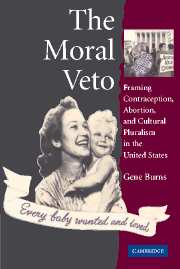Book contents
- Frontmatter
- Contents
- Acknowledgments
- 1 Introduction
- 2 Framing Contraception within Moral Worldviews: The Early, Radical Birth Control Movement
- 3 The Mainstreaming of Birth Control: A New Alliance with Eugenics and Medicine
- Dennett's Moral Worldview and the Catholic Moral Veto: Unsuccessful Frames for Contraception
- 5 Abortion before Controversy: Quiet Reform within a Medical, Humanitarian Frame
- 6 Abortion and Legislative Stalemate: The Weakness and Strength of the Medical, Humanitarian Frame
- 7 Looking Back: Limiting Frames, Moral Vetoes, and Cultural Pluralism
- Works Cited
- Index
2 - Framing Contraception within Moral Worldviews: The Early, Radical Birth Control Movement
Published online by Cambridge University Press: 21 July 2009
- Frontmatter
- Contents
- Acknowledgments
- 1 Introduction
- 2 Framing Contraception within Moral Worldviews: The Early, Radical Birth Control Movement
- 3 The Mainstreaming of Birth Control: A New Alliance with Eugenics and Medicine
- Dennett's Moral Worldview and the Catholic Moral Veto: Unsuccessful Frames for Contraception
- 5 Abortion before Controversy: Quiet Reform within a Medical, Humanitarian Frame
- 6 Abortion and Legislative Stalemate: The Weakness and Strength of the Medical, Humanitarian Frame
- 7 Looking Back: Limiting Frames, Moral Vetoes, and Cultural Pluralism
- Works Cited
- Index
Summary
Introduction
There is clear evidence of widespread interest in birth control in nineteenth-century America, from the demand for public lecturers on the subject, to the widespread circulation of books on contraception, and to the fact that Americans dramatically reduced the size of their families by the end of the nineteenth century. But, in 1873, a federal law known as the “Comstock law,” after its promoter Anthony Comstock, greatly restricted the circulation of information on, and sales of, contraceptives. The law treated contraception as a moral scandal. States followed with Comstock laws of their own which, while often not very consistently enforced, greatly discouraged access to contraception. Though there were small groups who criticized these restrictions, for the most part, in mainstream American society sexual topics were enough of a taboo that, before the 1910s, there was only occasional and sporadic public opposition to the Comstock laws.
But the 1910s were a decade of considerable social-movement activity. Protests in favor of women's suffrage, as well as other feminist causes, were in full swing, and in 1912 Socialist Party candidate Eugene V. Debs polled almost 6% of the votes in the U.S. presidential election. Scores of Socialists were elected mayors, hundreds obtained office in city councils, and one was even elected to the U.S. House of Representatives. The Socialist movement remained strong through the decade, until opposition to World War I among many American Socialists led to breaks within the ranks and to strong political repression during and after the war.
- Type
- Chapter
- Information
- The Moral VetoFraming Contraception, Abortion, and Cultural Pluralism in the United States, pp. 29 - 68Publisher: Cambridge University PressPrint publication year: 2005



